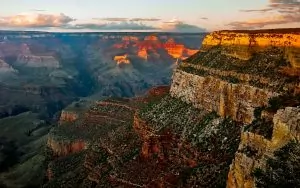Training For Your Trip
Get ready for your trip by being physically fit enough to have the time of your life.
When it comes to training, our mantra at Wildland Trekking is “the more physically prepared you are, the more fun you’ll have.” Training for your Wildland trip is about more than safety; it’s about enjoyment. Without training, many people may be able to complete the trip but by being in the best shape possible for your adventure you’ll maximize the fun!
IMPORTANT: The more physically prepared you are, the more fun you’ll have on your trip!

How Often to Train
- Begin training at least 12 weeks prior to your trip
- Train at least 3 days a week.
- Start with short hikes or workouts (1-2 hours in length) with a light daypack.
- Build the length and difficulty of your hikes and gradually increase your pack weight until you’re comfortably able to hike 6-8 hours a day carrying the weight you’ll have on your trip (refer to your trip packet for exact pack weight).
- Wear the boots you’ll have on your trip to break them in.
Suggested Training Schedule
* Train with these backpack weights:
- Backpacking Trips: 30 pound Backpack
- All Other Trip Types: 10-20 pound Backpack
| First Week | Work Up To | |
| Monday | — | 3 hour hike/workout with backpack * |
| Tuesday | 1-2 hour hike/workout with backpack * | — |
| Wednesday | — | 2 hour hike/workout with backpack * |
| Thursday | 1-2 hour hike/workout with backpack * | 3-4 hour hike/workout with backpack * |
| Sunday | 2-5 hour hike/workout with backpack * | 7-hour hike with the weight you’ll have on your trip (noted in your trip packet) |
Important: one week before your trip begins cut the regimen in half to avoid arriving fatigued and focus on stretching and staying hydrated.
Hike or CLIMB STAIRS
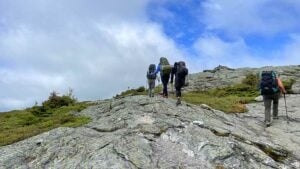
If you have access to hiking trails in hilly or mountainous terrain, then hiking locally is the ideal way to train. If not, we recommend actually training on stairs, or as an alternative using the Stairmaster machine with rotating stairs like an escalator. Nothing prepares you for a trip better than the activity itself!
Aside from hiking, stair climbing is the most effective way to train for areas with significant and sustained elevation gains and losses such as Grand Canyon, the Tetons, the North Cascades, the Himalayas, the Alps…etc.
If you don’t have access to great hiking, find a place where you can climb many flights of stairs in a single go such as a stadium or tall building. Otherwise climb the stairs at your office, house, park, or neighborhood. Begin your training at least 12 weeks prior to your trip and gradually increase the weight in your pack until you’re carrying the weight you’ll have on your trip (noted in your trip packet).
TRAINING FOR HIKING the Grand Canyon
The physical demands of hiking the Grand Canyon are in sharp contrast to those found in mountain climbing or hiking on relatively flat terrain. The first part of your hike will be a knee-jarring descent. The climb out will come when your legs are most tired and you’ll ascend into increasingly thin air as you near the rim at 7,000 feet, making it more difficult to breathe. Depending on whether you are on a hiking or backpacking trip you may also be carrying up to a 25-45+ pound backpack (exact pack weight depends on your body size and trip).
It’s beneficial to spend some of your time training for the downhill. Take an elevator to the top of a tall building and walk down the stairs, rather than up, to simulate the long descent into the Canyon. This will help build the strength you’ll need not just for descending but for going up as well.
GYM TRAINING
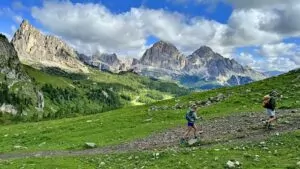 If a hiking routine is not practical you can adequately train for your trip in the gym. Be sure to begin exercising 3 times a week at a minimum for at least 30 minutes each time. Gradually increase the length and intensity of your workouts during the time you’re training for the trip. A program that improves your cardiovascular fitness and strength in all muscle groups is best for backpacking.
If a hiking routine is not practical you can adequately train for your trip in the gym. Be sure to begin exercising 3 times a week at a minimum for at least 30 minutes each time. Gradually increase the length and intensity of your workouts during the time you’re training for the trip. A program that improves your cardiovascular fitness and strength in all muscle groups is best for backpacking.
Activities may include swimming, step aerobics, treadmill, bicycling, or elliptical trainers to name a few. Swimming is a great way to build endurance and cardiovascular fitness and is easy on the joints. A modest weight training program focusing on the muscles that support the ankles, knees, back, and shoulders is also beneficial.
SUPPLEMENTAL TRAINING IDEAS
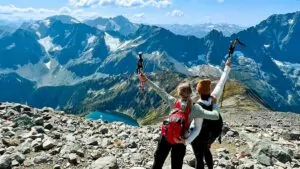 There are many other activities that are easily incorporated into your daily life to build your overall fitness. Cross training is important to strengthen opposing muscle groups and it helps to avoid over-use injuries. Supplemental training ideas include:
There are many other activities that are easily incorporated into your daily life to build your overall fitness. Cross training is important to strengthen opposing muscle groups and it helps to avoid over-use injuries. Supplemental training ideas include:
- Bike to work or when running errands. Bike around town or on country roads outside of your town/city. Cycling is a great way to build endurance and strength in your legs.
- Climb the stairs at your office, house, park, or neighborhood with a backpack. Stair climbing is a fantastic way to simulate backpacking in hilly or steep terrain.
- Yoga and/or Pilates classes can build strength throughout your body while also improving your flexibility.
- Intramural sports.
- Walk to work instead of driving. Run your errands by walking and carry your groceries home in a backpack.
- Jogging is another option, however if you are not a regular runner it can easily lead to injuries that backpacking may then exacerbate. Undertake a jogging routine with care.
FLEXIBILITY AND HYDRATION
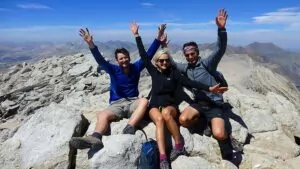 Flexibility is an important part of training. Remember to stretch before and after your workouts. For the two weeks leading up to your trip cut your workouts in half to avoid arriving fatigued. Also for a 72-hour period before your trip commences, ensure that you are consuming sufficient amounts of sodium and fluids. Doctors agree that hikers increase the likelihood of experiencing problems if they are sodium depleted (e.g., follow a low sodium diet) or are dehydrated (due to travel or using diuretics such as coffee or alcohol).
Flexibility is an important part of training. Remember to stretch before and after your workouts. For the two weeks leading up to your trip cut your workouts in half to avoid arriving fatigued. Also for a 72-hour period before your trip commences, ensure that you are consuming sufficient amounts of sodium and fluids. Doctors agree that hikers increase the likelihood of experiencing problems if they are sodium depleted (e.g., follow a low sodium diet) or are dehydrated (due to travel or using diuretics such as coffee or alcohol).
Important note: Always consult with your physician before commencing with a workout program.
*Being physically prepared for your backpacking trip is solely your responsibility. Guests who must be evacuated from a trip due to improper physical preparation will not receive any refunds and may be subject to additional expenses related to the evacuation.
Pack Light!
Lighter pack = increased fun and safety
To keep your pack light, scrutinize each item you plan on bringing in the field, and pack/purchase the lightest possible version of each item.
Ask yourself, does this item:
- protect me from the heat, cold, wind or rain?
- keep me hydrated?
- help my physical well-being?
- provide more value than it adds in weight?
If the answer to these questions is “no,” then it’s best to leave it at home!
Every Ounce Counts
Ounces make pounds and pounds make pain. Follow the packing list for your trip. Your guide will help you decide what to bring based on the current conditions.
Follow these tips to reduce weight:
- Do not bring a change of clothes for each day.
- Bring multiple changes of underwear and socks but leave extra pants and shirts behind.
- Don’t bring a thick book, heavy camera equipment…etc.
- Bring necessary medical devices and medications. Do not bring a First Aid Kit (your guide will have one).
- Do not pack a water filter or stove.
Understanding Your Trip’s Difficulty Level
A trip’s difficulty rating is based on the combination of all 4 of the sub-criteria ratings listed below. Refer to the trip packet for your specific trip’s ratings.
| Daily Distance | Elevation Gain/Loss | Terrain | Pack Weight | |
| Level 1 | Up to 4 miles | 250 feet | Mostly paved or boardwalking trails. | 10-15 pounds |
| Level 2 | Up to 6 miles | 750 feet | Moderately rugged with unmaintained trails made of dirt, rock, and sand with light exposure consisting of cliffs and drop-offs 10+ feet away. | 15-25 pounds |
| Level 3 | Up to 8 miles | 2,000 feet | Moderately rugged with unmaintained trails made of dirt, rock, and sand. May include off-trail hiking. | 25-35 pounds |
| Level 4 | Up to 10 miles | 3,000 feet | Significantly rugged terrain consisting of mainly off-trail hiking and can include steep, loose, and/or slippery sections. | 35-45 pounds |
| Level 5 | 10+ miles | 3,000+ feet | Significantly rugged terrain consisting of mainly off-trail hiking and can include steep, loose, and/or slippery sections with extreme exposure consisting of walking next to or on cliff edges and drop-offs. | 45+ pounds |




